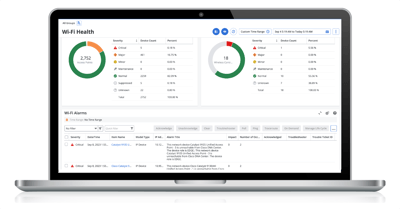|
Key Takeaways
|
|
In recent years, Wi-Fi has emerged as the de facto architecture for local area networks (LANs) and campus networks. Wi-Fi is also gaining more widespread usage in factories and operational technology environments.
Despite its ubiquity, Wi-Fi presents some persistent challenges for network operations center (NOC) teams. Fundamentally, it’s very difficult for these teams to ensure optimized service delivery in Wi-Fi environments, and track performance within the context of the complex networks that user transmissions are reliant upon.
Today, most network operations teams still monitor Wi-Fi as if it were a wired service, with no comprehension of aspects like radio integrity or user movement.
Think about it. Can your NOC team answer the following questions regarding Wi-Fi network delivery?
- How do I discover and visualize my multi-vendor wireless networks, and track them along with my wired and software-defined environments?
- How do I determine which infrastructure elements of my wireless network need attention now?
- How do I understand whether and how LAN, WAN, and SD-WAN outages affect the experiences of Wi-Fi users?
- How do I respond to localized challenges of slow Wi-Fi performance?
- How do I anticipate Wi-Fi performance issues before there’s an impact on users?
To gain this kind of visibility, you need a highly scalable, multi-vendor network management solution that correlates Wi-Fi, SDN, and traditional network events, along with radio frequency metrics to deliver a complete view of wireless network health.
 Software vendors must empower teams in today’s NOCs to monitor wireless networks using standard operational workflows for alarm management, ticketing, and triage. However, these workflows must also incorporate awareness of radio frequency metrics, noise level, interference, and wireless user demographics and movements. Level 2 and 3 NOC teams also need to apply field-proven analytics to Wi-Fi, incorporating factors like baselines, deviation from normal, time over threshold, and business hours.
Software vendors must empower teams in today’s NOCs to monitor wireless networks using standard operational workflows for alarm management, ticketing, and triage. However, these workflows must also incorporate awareness of radio frequency metrics, noise level, interference, and wireless user demographics and movements. Level 2 and 3 NOC teams also need to apply field-proven analytics to Wi-Fi, incorporating factors like baselines, deviation from normal, time over threshold, and business hours.
With these capabilities, you can expect to see these results:
- Faster delivery of new services to market
- More accurate ticketing for Wi-Fi issues and escalations
- Accelerated detection of the root cause of network issues
- Improved network availability
To learn more, be sure to check out a recent webcast I hosted: Wi-Fi, LAN, and WAN Performance for Your Enterprise Networks.

Jeremy Rossbach
As the Chief Technical Evangelist for NetOps by Broadcom, Jeremy is passionate about meeting with customers to identify their IT operational challenges and produce solutions that fit their business and network transformation goals. Prior to joining Broadcom, he spent over 15+ years working in IT, across both public...
Other resources you might be interested in
Why 2025 Shattered the Old Rules of Network Management
This post reveals the five key lessons network operations leaders learned in 2025—and how they need to respond to be successful in 2026.
The 2026 VMUG Report: Why Network Observability is the Heart of the New VCF Era
Get the top takeaways from the VMUG Cloud Operations and VCF User Experience Report 2026. See why network observability is key to successful VCF 9 migrations.
Automic Automation Cloud Integration: SAP S/4 HANA Application Jobs Integration
Simplify your SAP S/4HANA job management. Integrate with Automic Automation for central configuration, monitoring, and orchestration of all your enterprise jobs.
Automic Automation Cloud Integration: OpenSSH Integration
Master Open SSH automation. Use Automic Automation for centralized control, secure file transfer, command execution, and full job monitoring.
Rally Office Hours: December 11, 2025
Discover Rally's new Ancestors field, static query box deprecation, non-conflicting saves, plus a dashboard demo and query writing tips.
3 Questions I Expect You to Ask Me
Ask these questions to gain a deeper understanding of a vendor. Find a partner who can solve today’s challenges and prepare you for what’s next.
Carrier-Grade Network Observability: A Technology Brief for Telco Network Operations
Network Observability by Broadcom unifies data to provide contextual, AI-enabled insights for superior service availability, accelerated MTTR and improved MTTI, reduced operational costs, and the...
Rally Office Hours: December 4, 2025
Get the latest Rally updates, including a new Release Tracking page, and hear Q&A on revision history reporting, custom boards, and capacity planning.
You've Found the Waste In Your Network Operations. Now What?
Leverage the Six Sigma framework to gain a roadmap for converting network data into permanent optimizations. Start systematically eliminating network issues.